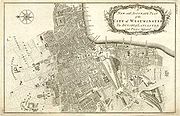
Benjamin Cole (instrument maker)
Encyclopedia

Surveying
See Also: Public Land Survey SystemSurveying or land surveying is the technique, profession, and science of accurately determining the terrestrial or three-dimensional position of points and the distances and angles between them...
, mapmaker, instrument maker, engraver and bookbinder living in Oxford
Oxford
The city of Oxford is the county town of Oxfordshire, England. The city, made prominent by its medieval university, has a population of just under 165,000, with 153,900 living within the district boundary. It lies about 50 miles north-west of London. The rivers Cherwell and Thames run through...
. His sons William and Benjamin were also instrument makers in London, while another son, Maximilian, was an engraver in Oxford.
Works
Benjamin Cole had a long-standing interest in freemasonryFreemasonry
Freemasonry is a fraternal organisation that arose from obscure origins in the late 16th to early 17th century. Freemasonry now exists in various forms all over the world, with a membership estimated at around six million, including approximately 150,000 under the jurisdictions of the Grand Lodge...
and engraved the frontispiece to the 1756 Book of Constitutions after succeeding John Pine
John Pine
John Pine was an English designer, engraver, and cartographer notable for his artistic contribution to the Augustan style and Newtonian scientific paradigm that flourished during the British Enlightenment.-Early life and apprenticeships:...
in 1743 as official engraver to the Grand Lodge
Grand Lodge
A Grand Lodge, or "Grand Orient", is the usual governing body of "Craft", or "Blue Lodge", Freemasonry in a particular jurisdiction. The first Masonic Grand Lodge was established in England in 1717 as the Premier Grand Lodge of England....
.
Cole drew up the ward maps for the first edition of the historian and topographer William Maitland's (c.1693–1757) posthumous History of London from Its Foundation to the Present Time (1769). (Cf. John Entick
John Entick
John Entick was an English schoolmaster and author. He was largely a hack writer, working for Edward Dilly, and he padded his credentials with a bogus M.A. and a portrait in clerical dress; some of his works had a more lasting value...
's New and Accurate History and Survey of London of 1766.) His music engravings included a collection by John Frederick Lampe
John Frederick Lampe
John Frederick Lampe was a musician.He was born in Saxony, but came to England in 1724 and played the bassoon in opera houses. His wife, Isabella Lampe, was sister-in-law to the composer Thomas Arne with whom Lampe collaborated on a number of concert seasons...
with a setting of the Entered Apprentice's Song. In 1728/9, he published a copy of the Old Charges with speeches by two Freemasons, Francis Drake
Francis Drake (antiquary)
Francis Drake was an English antiquary and surgeon, best known as the author of an influential history of York, which he entitled Eboracum after the Roman name for the city.- Early life :...
and architect Edward Oakley. His illustrations appeared in books ranging from fables for children to manuals of military drill, a notable work being a venture in collaboration with Edward Oakley, The Magazine of Architecture, Perspective, and Sculpture which provided an introduction to Palladian architecture
Palladian architecture
Palladian architecture is a European style of architecture derived from the designs of the Venetian architect Andrea Palladio . The term "Palladian" normally refers to buildings in a style inspired by Palladio's own work; that which is recognised as Palladian architecture today is an evolution of...
.
Cole made a wide range of instruments that are to be seen in museums throughout Britain. He was apprenticed to Thomas Wright and was free in the Merchant Taylors' Company. The firm of Wright & Cole operated until 1748 when Cole succeeded Wright. Cole & Son conducted their business between 1751 and 1766 from the Orrery adjoining the Globe Tavern, in Fleet Street
Fleet Street
Fleet Street is a street in central London, United Kingdom, named after the River Fleet, a stream that now flows underground. It was the home of the British press until the 1980s...
, London. This address became 136 Fleet Street about 1760 and 200 Fleet Street in later years. The business was taken over by John Troughton in 1782, surviving as Cooke, Troughton & Sims in the twentieth century.

Family
Cole started a dynasty of engravers to the Freemasons. His son Benjamin (1725-1813), was apprenticed to his father in 1739. Another son, William, worked as engraver to the Bank of EnglandBank of England
The Bank of England is the central bank of the United Kingdom and the model on which most modern central banks have been based. Established in 1694, it is the second oldest central bank in the world...
, and took over control and production of the freemasons' engraved lists in 1767. William’s son, John, founded a ‘Masonic Printing Office’ in London.

